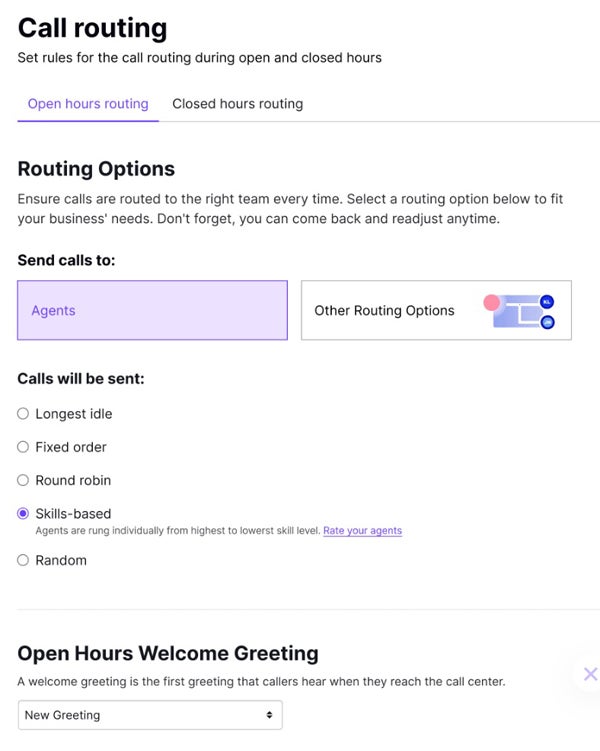
Call Routing Can Impact Your Company Image
-
by Anoop Singh
- 16
You’re busy, your customers are busy, and your team is busy. Strong call routing ensures nobody wastes their time — it’s a win-win for everyone involved.
Without call routing, a person answers the phone and manually forwards the caller where they need to go. At small volumes, this may work just fine. But for a larger business or even a period of time with an inbound surge, call routing can ease the burden on employees and reduce wait time for callers.
Traditional vs VoIP call routing
If you’ve tapped a number on your keypad, used voice commands to tell the system what you need, entered your account number, or done anything similar, you’ve interacted with a call routing system.
Simply put, a call routing system directs the flow of incoming calls. When done well, it greets each caller, places them in a queue, and quickly redirects them to the appropriate party.
Historically, businesses with landlines used the Public Switched Telephone Network (PSTN) or Plain Old Telephone Service (POTS) to route calls. This type of traditional call routing passes callers through a series of terminals and physical locations until they’re placed in a queue and eventually able to speak to the right person.
Private Branch Exchange (PBX) is a more modern alternative. Each business has its own central hub, with each user receiving a separate terminal and extension. While they work better than other legacy systems, PBX is still antiquated, difficult to scale, and requires physical infrastructure.
Voice over Internet Protocol (VoIP), on the other hand, leverages the internet instead of physical cables and wires. VoIP uses software to connect, making it easier for businesses to manage their call routing flows, program complex queue systems, add or remove users, and make updates any time they need to.
All of that happens through a user-friendly platform that’s easily accessible from a web browser, mobile phone, or desktop computer.

Call routing for a small business
You may think you’re too small of a business to benefit from call routing, but smaller businesses may actually have more to gain.
For starters, it gives the appearance that you’re larger than you may currently be.
This immediately instills trust in anyone who calls your business line. On top of that, it can help fill in the gaps when your team is busy with other tasks. If an employee is away from their phone, your call routing system can send the caller to someone else to ensure no call goes unanswered.
Call routing works well for after-hours and holidays, too. Rather than going straight to voicemail, you can decide what happens to the call based on the custom conditions that you program.
Ultimately, it gives you more control over the customer experience — and it can benefit your team, too. Rather than wasting time transferring calls, they’ll only receive calls they can actually handle themselves.
Advanced call routing with IVR
Interactive voice response is one of the most common advanced call routing tools. It works especially well for large businesses and high-volume call centers.
With IVR, callers use their keypad or voice to choose from a menu of options. There are usually multiple tiers that work together to gather information about the caller, route them to the correct department, or even help them answer their own questions.
Overall, IVR gives callers control and makes it easier for agents to understand what they need before they pick up the phone.
Callers tend to have a far better experience since they have multiple options. Plus, IVR can be faster than waiting for the next available agent — especially for making payments, managing their bank account, understanding business hours, getting your address, or answering commonly asked questions.
For example, a caller might:
- Select a specific department.
- Verbally state the purpose of their call.
- Work through a menu of frequent questions.
- Opt for a callback if their question isn’t answered.
Modern VoIP systems make building and managing IVR systems incredibly simple. They also make it easy to manage call queues in real time or via automation. Skills-based, preferred-agent, round-robin, geographic, and last agent spoken to are all common queue distribution tactics.
Integration with customer relationship management (CRM) software makes this even more appealing. When done correctly, your IVR system can pull information about the caller directly from your CRM and use it to direct the call where it needs to go.
For example, a regular high-ticket customer might be routed to your sales retention team if the customer’s contract is due for renewal.
These same call routing techniques can even be applied to text messages, emails, social media messages, and messaging apps. Combined, you get a well-oiled machine that directs every inquiry to the right place the first time.
Faster call routing isn’t always better
Many customers just want to talk to a human as quickly as possible. But getting them right to an agent isn’t always the best way to go.
Well-designed call routing can equip agents with additional context to help them serve the caller better and more quickly. While it may take a caller 30 more seconds to connect to an agent, by routing through an automated system, they may already be working to resolve the situation before they answer the phone.
It can also ensure they talk to the right person the first time. Nobody likes being on hold or having to explain what’s going on multiple times to different people. So, those few extra seconds may save the customer from a frustrating experience.
You may even be able to side-step human interaction all together. Automated menus can assist in a wide range of scenarios, such as resetting a PIN number, making payments, checking an account balance, or getting the dates and times of upcoming events.
Wondering which IVR system is best for your business? Check out my latest roundup of the best IVR systems on the market.
You’re busy, your customers are busy, and your team is busy. Strong call routing ensures nobody wastes their time — it’s a win-win for everyone involved. Without call routing, a person answers the phone and manually forwards the caller where they need to go. At small volumes, this may work just fine. But for a…
You’re busy, your customers are busy, and your team is busy. Strong call routing ensures nobody wastes their time — it’s a win-win for everyone involved. Without call routing, a person answers the phone and manually forwards the caller where they need to go. At small volumes, this may work just fine. But for a…
